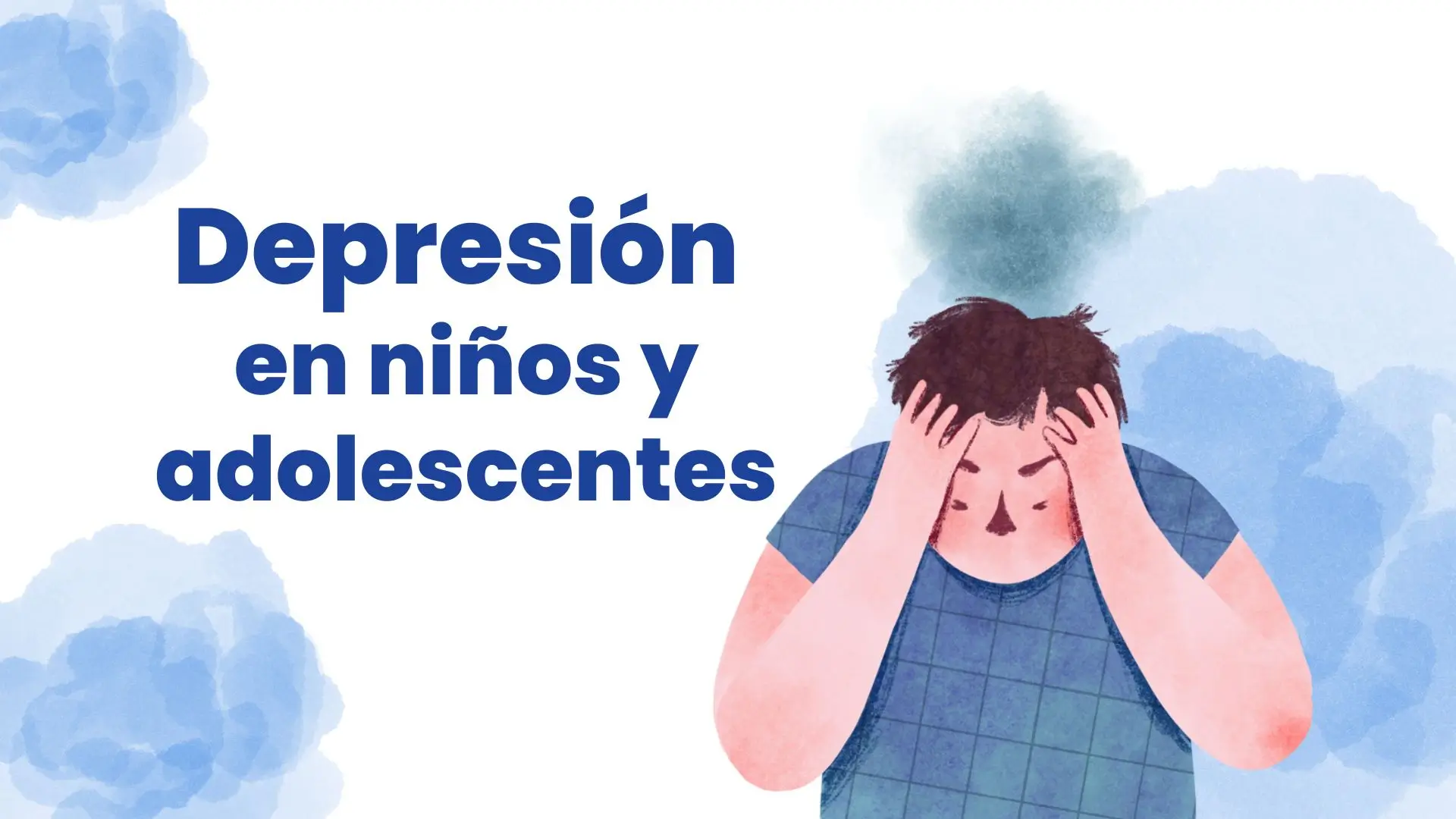Comprender la depresión en adolescentes y niños es crucial para padres, educadores y profesionales sanitarios. La depresión puede manifestarse de forma diferente en los jóvenes, por lo que es esencial conocer los signos y síntomas. Además, es fundamental comprender las causas y los factores subyacentes que contribuyen a la depresión en este grupo de edad. Si comprendemos mejor la depresión en adolescentes y niños, podremos proporcionarles apoyo y tratamiento eficaces para ayudarles a superar este difícil problema de salud mental. En este blog, exploraremos los signos, las causas y las opciones de tratamiento de la depresión en individuos jóvenes, con el objetivo de arrojar luz sobre este tema a menudo incomprendido.
Reconocer los signos de la depresión
Un niño deprimido puede mostrar una pérdida de interés en actividades que antes disfrutaba, lo cual es uno de los signos más evidentes de un cambio en su bienestar emocional. Además, los cambios en los patrones de sueño, como el insomnio o dormir en exceso, pueden ser una señal de depresión y no deben ser pasados por alto. A menudo, el aislamiento social y la retirada de amigos y familiares es otro signo importante de depresión, ya que el niño o adolescente puede sentirse incapaz de mantener sus relaciones personales. También es común observar una disminución notable en el rendimiento escolar y la falta de concentración, lo que puede indicar un problema de salud mental subyacente. Estos signos, aunque variados, juntos pueden proporcionar una imagen clara de que algo no está bien y requieren atención inmediata.
Cambios de comportamiento
La depresión en niños y adolescentes puede manifestarse a través de cambios significativos en su comportamiento diario. Frecuentemente, los niños pueden volverse más irritables o tener arrebatos de ira con mayor frecuencia, lo que puede ser alarmante para los padres y maestros. Además, puede observarse una disminución en el interés por actividades que antes disfrutaban, lo cual es un claro indicio de que su bienestar emocional está comprometido. Cambios en los patrones de sueño, como insomnio o dormir en exceso, son también comunes y pueden afectar negativamente su energía y estado de ánimo durante el día. Asimismo, estos jóvenes pueden enfrentar dificultades para concentrarse en la escuela o en otras actividades, lo que lleva a un deterioro en su rendimiento académico y genera preocupación en su entorno. Reconocer y entender estos cambios de comportamiento es fundamental para ofrecer el apoyo adecuado y buscar tratamiento profesional que pueda ayudarles a superar esta etapa difícil.
A menudo se presentan síntomas emocionales
Muchos niños que sufren depresión experimentan una tristeza persistente que afecta significativamente a su vida diaria, interfiriendo en sus actividades cotidianas y relaciones personales. A menudo, esta tristeza va acompañada de una pérdida de interés en actividades que antes les resultaban placenteras, como jugar con amigos o participar en deportes, lo que puede ser un claro indicador de su malestar emocional. Además, es común que estos niños muestren irritabilidad y cambios de humor frecuentes, sorprendiendo a padres y educadores que no están acostumbrados a tales reacciones. Pueden también presentar sentimientos de inutilidad o una culpa excesiva sin razón aparente, lo que agrava aún más su estado emocional y refuerza la necesidad de una intervención temprana. Estos síntomas emocionales, cuando se presentan juntos, subrayan la importancia de estar atentos y proporcionar el apoyo necesario para ayudar a los niños a superar la depresión.
Reconocer los signos de la depresión
Un niño deprimido puede mostrar una pérdida de interés en actividades que antes disfrutaba, lo cual puede ser uno de los primeros indicios de un problema subyacente. Además, los cambios en los patrones de sueño, como insomnio o dormir en exceso, también pueden ser una señal de depresión. A menudo, estos jóvenes comienzan a aislarse socialmente, retirándose de amigos y familiares, lo que agrava aún más su sensación de soledad y desesperanza. No menos importante es la disminución notable en el rendimiento escolar y la falta de concentración, elementos que pueden ser fácilmente observados tanto por padres como por maestros. Identificar estas señales tempranamente es crucial para brindar el apoyo y tratamiento necesarios para mejorar su bienestar mental.
Predisposición genética y antecedentes familiares
La predisposición genética puede aumentar significativamente el riesgo de depresión infantil, especialmente en niños cuyos padres también sufren trastornos del estado de ánimo. Los antecedentes familiares de depresión no sólo influyen en la aparición de síntomas depresivos en los niños, sino que pueden manifestarse incluso a edades tempranas. Existen factores hereditarios que predisponen a los menores a desarrollar depresión, particularmente si hay una historia familiar extensa de problemas de salud mental. Además, el ambiente familiar y la genética juegan un papel crucial en esta predisposición, con estudios que indican una mayor incidencia de depresión en familias con antecedentes de trastornos depresivos. En conjunto, estos elementos subrayan la importancia de un enfoque preventivo y de apoyo para aquellos niños que tienen un mayor riesgo debido a su historia familiar.
Factores ambientales y acontecimientos vitales
La exposición a conflictos familiares puede aumentar significativamente el riesgo de depresión infantil, creando un ambiente inestable y emocionalmente cargado que afecta al bienestar mental de los niños. Además, un entorno escolar negativo, incluido el acoso, puede contribuir a problemas de salud mental, ya que los niños que enfrentan bullying a menudo se sienten aislados y desamparados. Eventos traumáticos como la pérdida de un ser querido pueden desencadenar episodios depresivos en los pequeños, dejándolos abrumados por emociones de tristeza y desesperanza. La falta de apoyo social y emocional en el hogar no hace más que exacerbar estos síntomas, impidiendo que los niños encuentren consuelo y seguridad en su entorno más cercano. En conjunto, estos factores crean un contexto desafiante que requiere una atención y cuidado especial para mitigar el impacto de la depresión en la vida de los niños.
Causas comunes de la depresión en los jóvenes
Las presiones académicas pueden causar un estrés significativo en los jóvenes, contribuyendo de manera considerable a la aparición de la depresión. En muchos casos, las dificultades en las relaciones familiares, como el conflicto constante o la falta de apoyo emocional, también desempeñan un papel crucial en el desarrollo de la depresión juvenil. Además, el acoso escolar y el ciberacoso son factores desestabilizadores que pueden llevar a sentimientos profundos de aislamiento y desesperanza entre los adolescentes. La influencia de las redes sociales no se queda atrás, ya que la constante presión por cumplir con ciertos estándares de belleza y éxito puede impactar negativamente en la salud mental de los jóvenes. En conjunto, estos factores crean un entorno emocionalmente tóxico que puede ser muy difícil de manejar para los adolescentes, subrayando la necesidad de un apoyo emocional y psicológico adecuado.
Ciberacoso y acoso en línea
El ciberacoso puede tener efectos devastadores en la salud mental de los jóvenes, incluyendo ansiedad y depresión, generando un entorno de estrés constante que resulta difícil de manejar. Las plataformas de redes sociales a menudo se convierten en escenarios principales para el acoso en línea, donde los agresores pueden actuar de manera anónima, amplificando el daño y el miedo en las víctimas. Es crucial que los padres y educadores estén atentos a las señales de ciberacoso, tales como cambios en el comportamiento, aislamiento social y disminución del rendimiento académico, proporcionando el apoyo emocional y psicológico necesario para ayudar a los jóvenes a superar esta difícil situación. Sin embargo, las leyes y políticas de ciberacoso varían significativamente de un país a otro, lo que puede complicar la protección de los usuarios en línea y la implementación de medidas efectivas para prevenir este tipo de acoso. Por ello, es esencial promover la concienciación y la educación sobre el ciberacoso, tanto a nivel familiar como institucional, para crear un entorno seguro y de apoyo para los jóvenes en el mundo digital.
Comparación social y problemas de autoestima
La comparación social puede alterar significativamente la percepción de uno mismo, llevando a una autoestima debilitada y una autoimagen distorsionada. Los niños que se encuentran constantemente midiendo su valor en relación con sus compañeros pueden desarrollar profundos sentimientos de inferioridad, sintiéndose siempre un paso por detrás de los demás. La exposición continua a las redes sociales amplifica estas oportunidades de comparación, ya que las imágenes y publicaciones idealizadas de otros pueden hacer que los jóvenes se sientan aún más inadecuados. Este ciclo de comparación y baja autoestima puede ser difícil de romper, pero es esencial fomentar una autoevaluación positiva y la autocompasión en los niños. Enseñarles a valorarse por sus propias cualidades y logros, en lugar de compararse con los demás, puede contrarrestar los efectos negativos de la comparación social. Al promover un enfoque más saludable hacia la autoevaluación, ayudamos a los jóvenes a construir una autoestima sólida y resiliente, capaz de resistir las presiones externas.
Causas comunes de la depresión en los jóvenes
Las presiones académicas pueden causar estrés significativo en los jóvenes, contribuyendo a la depresión de manera considerable. Además, las dificultades en las relaciones familiares, como el conflicto constante o la falta de apoyo emocional, pueden ser un factor importante que agrava la depresión juvenil, dejando a los adolescentes sin un refugio seguro en sus propios hogares. El acoso escolar y el ciberacoso también desempeñan un papel crucial, ya que pueden llevar a sentimientos de aislamiento y desesperanza, erosionando la autoestima y el sentido de pertenencia de los jóvenes. La influencia de las redes sociales no se queda atrás; la constante exposición a estándares inalcanzables y la presión por cumplir con ciertas expectativas pueden impactar negativamente en la salud mental de los adolescentes, haciéndolos sentir inadecuados y aún más vulnerables. Todos estos factores, combinados, crean un entorno donde la depresión puede florecer, subrayando la necesidad de un enfoque integral para abordar estos desafíos.
Enfoques terapéuticos: TCC, TDC y más
La Terapia Cognitivo-Conductual (TCC) se centra en identificar y cambiar patrones de pensamiento negativo, ayudando a los jóvenes a desarrollar una perspectiva más equilibrada y realista. La Terapia Dialéctico-Conductual (TDC), por su parte, combina técnicas de TCC con conceptos de aceptación y regulación emocional, proporcionando herramientas adicionales para manejar las emociones intensas y la impulsividad. Para los niños más pequeños, la terapia de juego resulta especialmente útil, ya que les permite expresar sus emociones y conflictos internos en un entorno seguro y controlado, facilitando la comunicación y el procesamiento emocional. Al mismo tiempo, la terapia familiar involucra a los miembros de la familia, abordando dinámicas disfuncionales y mejorando la comunicación, lo que crea un entorno de apoyo más cohesivo y efectivo para la recuperación del niño o adolescente. En conjunto, estos enfoques terapéuticos ofrecen una variedad de herramientas y estrategias adaptadas a las necesidades específicas de cada individuo, promoviendo un camino integral hacia el bienestar emocional y psicológico.
El papel de la medicación en el tratamiento
La medicación puede ser una herramienta eficaz para aliviar los síntomas graves de la depresión infantil, proporcionando un alivio significativo que permite a los niños empezar a funcionar mejor en su vida diaria. Sin embargo, es crucial combinar la medicación con terapia psicológica para un enfoque integral del tratamiento, asegurando que no sólo se aborden los síntomas, sino también las causas subyacentes y los patrones de pensamiento negativo. Los medicamentos deben ser administrados y supervisados por profesionales de la salud mental con experiencia en pediatría, quienes están capacitados para dosificar adecuadamente y monitorizar los efectos en un organismo en desarrollo. Además, es importante monitorizar de cerca a los niños que toman medicación para ajustar las dosis según sea necesario y manejar posibles efectos secundarios, garantizando así que el tratamiento sea tanto seguro como efectivo. Este enfoque integral y supervisado permite una intervención más completa y adaptada a las necesidades específicas de cada niño, promoviendo una recuperación más estable y duradera.
El impacto de las redes sociales en la salud mental de los jóvenes
El uso excesivo de las redes sociales puede llevar a sentimientos de aislamiento y baja autoestima en los jóvenes, ya que la interacción virtual a menudo reemplaza el contacto humano directo, esencial para un desarrollo emocional saludable. Las redes sociales, además, tienden a promover expectativas poco realistas de la vida y la apariencia física, lo cual puede contribuir significativamente a la ansiedad y la depresión al hacer que los jóvenes se sientan inadecuados en comparación con las imágenes idealizadas que ven en línea. La exposición constante a contenido negativo o al ciberacoso también afecta profundamente la salud mental de los jóvenes, generando un entorno de estrés y miedo que puede ser difícil de manejar. Por otro lado, el tiempo dedicado a las redes sociales puede interferir con el sueño y las actividades físicas, ambos cruciales para el bienestar mental. En consecuencia, la dependencia de las redes sociales crea un ciclo perjudicial que es vital abordar para proteger la salud emocional de los adolescentes.
Estrategias parentales de apoyo
Fomentar una comunicación abierta y sincera con los hijos es crucial para que se sientan cómodos compartiendo sus sentimientos y preocupaciones, lo que puede ser especialmente importante durante momentos de estrés o dificultad emocional. Establecer rutinas diarias proporciona una estructura y seguridad que ayuda a los niños a desarrollar hábitos saludables, creando un entorno predecible y estable en el que pueden prosperar. Practicar la escucha activa y mostrar empatía no sólo valida las emociones de los hijos, sino que también fomenta un ambiente de apoyo emocional en el que se sienten comprendidos y valorados. Promover actividades familiares que fortalezcan los lazos afectivos ofrece oportunidades valiosas para el desarrollo social y emocional, permitiendo a los niños construir relaciones sólidas y significativas dentro de un contexto de amor y apoyo. Este enfoque integral no solo mejora el bienestar emocional de los niños, sino que también fortalece la cohesión familiar, creando un entorno más saludable y feliz para todos.
Recursos e intervenciones escolares
Implementar programas de apoyo emocional y psicológico en las escuelas es esencial para proporcionar a los estudiantes un entorno saludable y seguro donde puedan abordar sus preocupaciones emocionales. Formar a los profesores en técnicas de identificación y manejo de problemas emocionales permite una detección temprana y una intervención oportuna, asegurando que los estudiantes reciban el apoyo necesario antes de que sus problemas se agraven. Además, desarrollar actividades extracurriculares que promuevan la socialización y el bienestar no solo fomenta un sentido de comunidad entre los estudiantes, sino que también ofrece un espacio para que se expresen y manejen el estrés de manera constructiva. Establecer protocolos claros para la intervención en casos de crisis emocional es fundamental, ya que proporciona una guía estructurada para actuar de manera rápida y efectiva, minimizando el impacto negativo de la situación y asegurando que los estudiantes reciban la ayuda inmediata que necesitan. En conjunto, estas iniciativas crean un entorno escolar más inclusivo y resiliente, donde el bienestar emocional de los estudiantes es una prioridad.
El impacto de las redes sociales en la salud mental de los jóvenes
El uso excesivo de las redes sociales puede llevar a sentimientos de aislamiento y baja autoestima en los jóvenes, ya que la interacción virtual a menudo reemplaza las conexiones personales significativas. Las redes sociales, con sus imágenes editadas y vidas aparentemente perfectas, promueven expectativas poco realistas de la vida y la apariencia física, lo cual puede contribuir a la ansiedad y la depresión entre los adolescentes que se sienten incapaces de cumplir con esos estándares inalcanzables. Además, la exposición constante a contenido negativo o a ciberacoso puede afectar significativamente la salud mental de los jóvenes, creando un entorno de estrés y vulnerabilidad emocional. El tiempo dedicado a las redes sociales también interfiere con el sueño y las actividades físicas, ambos elementos cruciales para el bienestar mental, dejando a los jóvenes en un estado de agotamiento y malestar general que sólo agrava sus problemas emocionales. En conjunto, estos factores subrayan la importancia de un uso equilibrado y consciente de las redes sociales para proteger la salud mental de los jóvenes.
Tratamientos eficaces para la depresión adolescente
La terapia cognitivo-conductual se ha demostrado como una herramienta eficaz para ayudar a los adolescentes a identificar y cambiar patrones de pensamiento negativo, promoviendo así una mejor salud mental. Bajo la supervisión de un profesional de la salud, el uso de medicamentos antidepresivos puede ser una opción viable para aquellos jóvenes cuya depresión es más severa, proporcionando un alivio necesario mientras se trabaja en otras áreas del tratamiento. Además, la terapia familiar juega un papel crucial al mejorar la dinámica y el apoyo dentro del hogar, creando un entorno más favorable para la recuperación del adolescente. Complementando estas intervenciones, la actividad física regular también ha mostrado tener efectos positivos significativos en el estado de ánimo y la salud mental de los adolescentes, ayudándoles a liberar endorfinas y reducir el estrés. En conjunto, estos enfoques ofrecen un tratamiento integral que puede abordar las múltiples facetas de la depresión adolescente, proporcionando un camino más claro hacia la recuperación y el bienestar.
Cómo ayudar a un niño con depresión
Proporcionar un ambiente de apoyo donde el niño se sienta escuchado y comprendido es esencial para ayudarles a enfrentar la depresión. Fomentar actividades físicas y creativas puede mejorar significativamente su estado de ánimo, ya que estas actividades no solo ofrecen una distracción saludable, sino que también liberan endorfinas que promueven el bienestar emocional. Mantener una comunicación abierta y sincera sobre sus sentimientos y emociones es crucial, permitiéndoles expresar sus preocupaciones y sentir que no están solos en su lucha. Sin embargo, si los síntomas persisten, es imperativo buscar la ayuda de un profesional de la salud mental. La intervención temprana y adecuada puede marcar una diferencia significativa en la vida del niño, proporcionando estrategias y tratamientos efectivos para superar la depresión.
Conclusión
En resumen, comprender la depresión en adolescentes y niños es un primer paso crucial para abordar este complejo y desafiante problema de salud mental. Reconocer los signos tempranos, como la pérdida de interés en actividades, cambios en los patrones de sueño, aislamiento social, y disminución en el rendimiento escolar, puede permitir una intervención más oportuna y efectiva. La predisposición genética, los antecedentes familiares, los factores ambientales y los acontecimientos vitales juegan un papel significativo en la aparición de la depresión, subrayando la necesidad de una evaluación cuidadosa y un enfoque multidimensional en el tratamiento.
Los enfoques terapéuticos como la Terapia Cognitivo-Conductual (TCC) y la Terapia Dialéctico-Conductual (TDC), junto con la terapia de juego y la terapia familiar, ofrecen diversas herramientas para abordar los patrones de pensamiento negativo y mejorar la regulación emocional. La medicación, cuando es necesaria, debe administrarse bajo estricta supervisión profesional para garantizar su eficacia y seguridad. Además, es esencial prestar atención al impacto de las redes sociales, que pueden exacerbar los sentimientos de aislamiento y baja autoestima en los jóvenes.
A nivel familiar, fomentar la comunicación abierta, establecer rutinas diarias, practicar la escucha activa y promover actividades familiares son estrategias clave para proporcionar un entorno de apoyo. En el ámbito escolar, implementar programas de apoyo emocional, formar a los profesores y desarrollar actividades extracurriculares puede crear un entorno más inclusivo y resiliente para los estudiantes.
Finalmente, ayudar a un niño con depresión requiere un enfoque integral que combine el apoyo emocional, la intervención profesional y la promoción de hábitos saludables. Al proporcionar un entorno seguro y comprensivo, y al buscar la ayuda adecuada cuando sea necesario, podemos marcar una diferencia significativa en la vida de los niños y adolescentes que enfrentan la depresión, ayudándoles a recuperar su bienestar emocional y su calidad de vida.











1 comentario en “Depresión Infantil: Signos, Causas y Tratamientos Eficaces”
Me gustan algunas causas que mencionas, me servirán para estar más atenta a mi hija